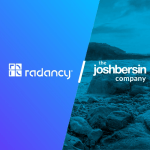Today’s competitive hiring landscape brings real opportunity for employers to hone in on effective recruitment strategies. Job candidates now have more choice and control in the job application process than ever before, which makes it essential for recruiters to know the ins and outs of the candidate journey.
To help guide recruiters in optimizing their campaigns for candidate experience, this post will explore:
- The importance of the candidate journey in building an application funnel
- How to utilize the candidate journey when planning successful recruitment advertising campaigns
Be “candidate first”: Building an application funnel based on candidate experience
The world of recruitment has evolved alongside the changing landscapes of marketing and sales. Just as consumers have become the focal point for shaping major advertising and sales campaigns, so too have candidates become the first source of data for hiring strategies.
Consider the traditional ways in which employers reach candidates: “help wanted” ads, job boards, job ads with mile-long lists of requirements, etc. While these methods still have a place in the job market, they need to be complemented by candidate-centric tools and technologies that allow employers to gain competitive advantage. As a result, they tend to only attract active job seekers who may not be the best fit for the job.
Adopting a “candidate first” perspective allows recruiters to optimize their available sourcing channels and attract passive job seekers. This can be done in four stages:
- Researching and understanding the needs of the job seeker
- Identifying recruitment opportunities based on those needs
- Generating actionable ideas to turn those opportunities into results
- Applying the ideas in the application funnel
An application funnel based on real candidate experience is considered a best practice for user experience, as well as a type of “human-centric design.” Recruiters looking to get ahead in the hiring market should keep candidates at the heart of their decision-making.
The candidate journey: A customized framework for talent acquisition
Recruiters monitor and measure multiple sources of data at once, which is why the candidate journey is a particularly useful tool for optimizing recruitment strategies. The framework – modeled from the customer journey concept in marketing – allows recruiters to structure the job candidate experience and identify opportunities to strengthen interactions between candidate and employer.
A typical candidate journey is outlined below, with common recruitment strategies also included for each stage:
Recruitment – The goal of this stage is to source the right amount of quality applicants for any job. Strategies that involve employer branding and candidate sourcing fall into this area, and is further divided into the following steps:
Awareness: Employer branding plays a leading role in how job seekers discover open positions via display ads, job boards, text message ads or social media.
Consideration: Retargeting and email/text alerts come into play as job seekers consider applying to a position.
Application: Programmatic ads and strategic touchpoints guide candidates through the application funnel, which is when job seekers become applicants.
Retention – Once a candidate is hired, the focus shifts to activity that indicates value and productivity. Metrics of note include lifetime value (LTV), quality of hire (QoH), time to productivity, and overall retention rates, among others. The steps involved in retention are:
Onboarding: New hires receive alerts or ads that offer bonuses and incentives as part of their new position.
Advocacy: New hires bolster the recruitment process by encouraging more candidates to apply. This can happen through programmatic engagement, referrals, social media presence or content ads.
The above factors provide the backbone of a candidate journey map. While candidate journeys vary across companies, most recruiters benefit from supplementing these stages with additional data (e.g. detail on user personas/profiles, candidate emotions, candidate experience at specific touchpoints, channel analysis).
Activation: Using programmatic recruitment platforms to leverage insights from the candidate journey
Recruiters can utilize programmatic recruitment platforms to harness and analyze data related to the candidate journey. This allows for further campaign optimization and ensures that hiring strategies remain candidate-centric.
Programmatic recruitment platforms provide recruiters with a competitive edge through benefits such as:
- Audience Extension – Job ad management across job boards, display, social, and all other relevant job seeker touchpoints. Reach active and passive job seekers across the entire web.
- Campaign Automation – Automation of recruitment workflows to focus on high-value tasks.
- Budgeting Intelligence – Optimization of recruitment investment. TMP Programmatic generates useful insights and automatically deploys recruitment budgets in the most effective way.
- Business Intelligence – Leverage of TMP’s analytics and data platform to improve recruitment campaigns.
- Programmatic Standard – Integration of supply and tracking partners.
Bottomline: A candidate-centric recruitment strategy improves results
Recruitment in a competitive hiring landscape requires a deep understanding of job candidate behaviors. By adhering to a “candidate first” mentality, recruiters can shape more effective hiring strategies and build far-reaching campaigns.
Programmatic recruitment platforms allow employers to harness valuable data from the candidate journey. A comprehensive understanding of candidate experience coupled with the right programmatic platform can provide a boost in hiring initiatives and better ROI for employers.
- TMP Programmatic Jobs: Audience Extension - October 8, 2020
- Radancy’s Programmatic Jobs – Part 3: Business Intelligence - March 18, 2020
- Radancy’s Programmatic Jobs – Part 2: Budgeting Intelligence - February 19, 2020
- Radancy’s Programmatic Jobs – Part 1: Campaign Automation - January 28, 2020
- Putting Candidates at the Center of Your Recruitment Strategy - December 17, 2019
- In Pursuit of Perfection: Using Testing for Conversion Rate Optimization - November 22, 2019
- Job Content 101: How to Optimize Job Ads for Results - November 5, 2019
- Recruitment Automation: How to Automate Applicant Sourcing - October 22, 2019
- Recruitment Analytics 101: How to Collect and Analyze Data for Recruitment Success - September 11, 2019
- Recruitment Funnel: How to Optimize the Job Applicant Experience - August 19, 2019










